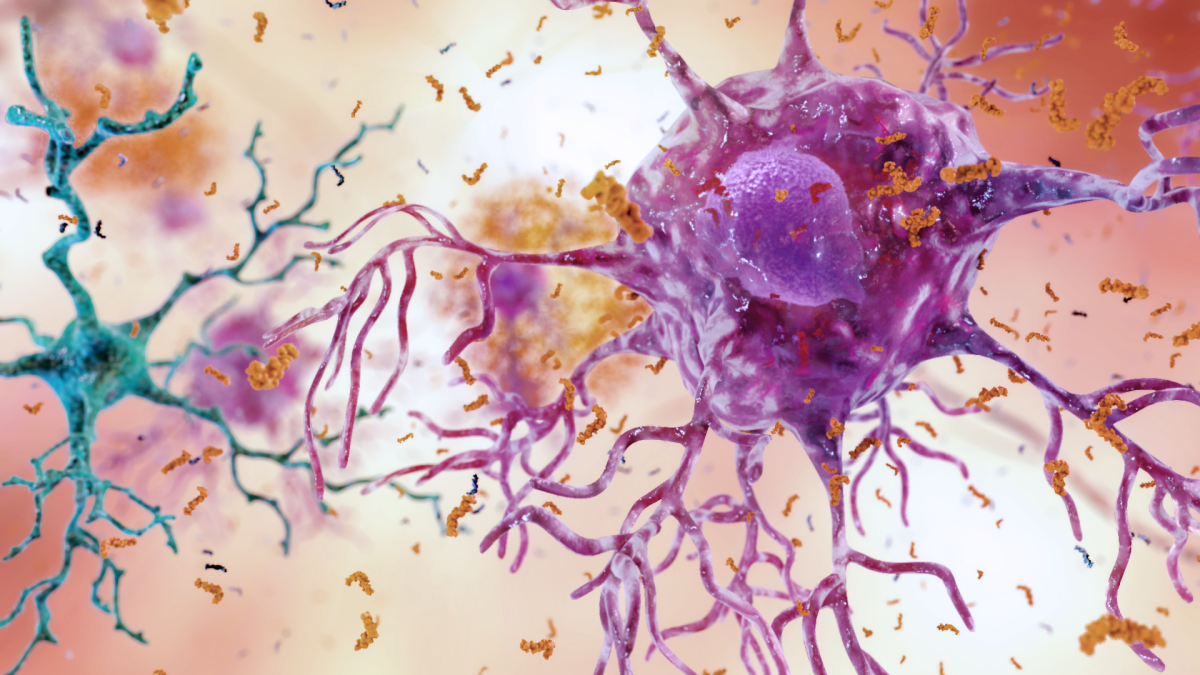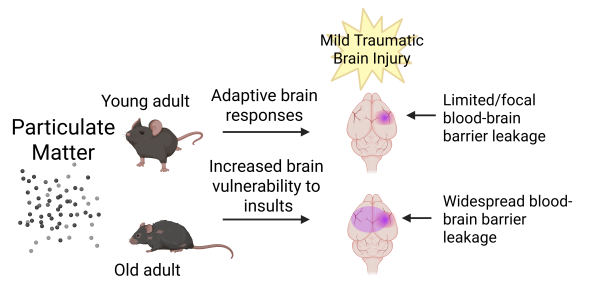
The root causes of Alzheimer’s disease are complex and likely involve multiple risk factors that increase a person’s chances of developing the disease. Conducting lab experiments to study the combined effects of risk factors like aging, exposure to air pollution, and traumatic brain injury is complicated and ambitious. But Michelle (Shelly) Erickson is interested in finding better cures for Alzheimer’s disease, so understanding the interactions of multiple variables is critical.

Erickson is a research associate professor with the University of Washington (UW) Division of Gerontology and Geriatric Medicine and a research biologist at the Seattle Veterans Affairs Puget Sound Health Care System. In 2024, she was awarded a pilot grant from the UW Interdisciplinary Center for Exposures, Diseases, Genomics & Environment (EDGE) to fund her work on interacting brain vulnerabilities for Alzheimer’s disease.
Erickson has a personal interest in Alzheimer’s disease having watched her grandmother die from it. “I don’t want to see that happen to my mom or other people that I love, so I think we need better treatments and preventative strategies for Alzheimer’s,” said Erickson. “I think we need some new thinking, and one of the ways we could think about prevention is about mitigating the risk factors.”
Traumatic Brain Injury
One such risk factor for Alzheimer’s disease is traumatic brain injury. Among the Veterans whom Dr. Erickson’s research program serves, traumatic brain injury is a pressing concern, with many having suffered head injuries in combat and also in older age. More broadly, Erickson says that about 1.5 million people in the U.S. suffer traumatic brain injuries every year. The most common cause of traumatic brain injury in older adults is falls and the second most common cause is automobile accidents.
“About 90% of traumatic brain injuries are mild,” said Erickson “so that became important with our modeling.” Erickson used a protocol that was developed 10 years ago by her co-Investigator, William Banks, as part of a summer project for medical students. It involves a metal rod operated by a magnet that delivers a precisely controlled impact to the head of an anesthetized mouse. The skull and skin stay intact and there is no loss of consciousness in young mice, but there is evidence of damage to the brain’s blood vessels that results in small molecules in blood being able to leak through to the brain, referred to as blood-brain barrier disruption. This abnormal leakage of small molecules can alter the brain’s ability to function properly, and over time, may contribute to Alzheimer’s disease.
Erickson and her team found that the response of older mice to this mild injury was more pronounced than that of younger mice, mirroring what is seen in humans. “An injury of lesser magnitude that maybe has no effect on a young person can actually have some pretty substantial effects in an older adult,” explained Erickson.
Air Pollution
To simultaneously address the impact of air pollution Erickson took advantage of the UW Controlled Exposure Laboratory—a facility that allows researchers to expose animals and human study participants to carefully controlled concentrations of particulate matter from diesel exhaust.
For her experiments, Erickson exposed mice to diesel exhaust for six hours a day, five days a week, for two weeks prior to brain injury. “We used a concentration that would reflect fairly high levels that one might experience at near-road conditions,” she explained. Control mice were exposed to filtered air.
“We know that 10 million Veterans live in areas of the United States that have unhealthy levels of air pollution,” said Erickson, “so this is an issue relevant to Veterans as well as the civilian population.”
Statistical Analysis
The study design used statistical methods to analyze the individual effects of age, air pollution exposure, and traumatic brain injury, as well as the combined effects of these factors on outcomes that were measured. One outcome that stood out was blood-brain barrier disruption. “We didn’t see traumatic brain injury causing any widespread blood-brain barrier leakage throughout the brain unless we had that combination of aging and air pollution exposure together,” said Erickson.

Created in BioRender. Erickson, M. (2025) https://BioRender.com/
up7cw6y
“What this indicates is that there’s synergy between two of the risk factors for Alzheimer’s disease—aging and air pollution exposure—that could ultimately be unmasked when there’s brain injury,” explained Erickson. The combination of underlying risk factors resulted in a more severe response to an injury. “That was our hypothesis,” said Erickson.
“Our results are important to think about when we’re considering how we build research models because a lot of the time somebody will start with a research model that’s pretty severe because they’re looking for an outcome,” said Erickson. “But in doing that we may miss more subtle changes, effects, and vulnerabilities that underlie a response to damage like blood-brain barrier disruption.”
New Avenues of Research
Managing the lab experiments with so many variables was complicated. Erickson credits EDGE member Judit Marsillach, an assistant professor in the UW Department of Environmental and Occupational Health Sciences, with helping her navigate the Controlled Exposure Laboratory. Recently the two submitted a grant proposal for R21 funding from the National Institutes of Health to build on the success of Erickson’s pilot.
One of the goals of this proposal is to understand how proteins in the blood vessels of the brain change following exposures to diesel exhaust and traumatic brain injury, particularly in older age, using an advanced method called proteomics. Proteomics is the study of protein structure and how proteins function and interact in biological systems. “We want to understand the proteomic changes that happen at the brain microvasculature,” said Erickson. Understanding vulnerabilities in these smallest of blood vessels could potentially lead to the development of therapeutic treatments that can prevent harmful blood-brain barrier leakage.
The proposal also includes looking at longer term effects of the brain injury and diesel exposure in the context of aging. “Over 50% of folks who have experienced mild traumatic brain injury have persistent impairments 12 months post-injury that can be quite debilitating,” said Erickson, “I think we need to understand not only the acute injury processes but also the repair processes and the role of air pollution there.”
Ultimately Erickson’s new model opens up many new avenues of research—exactly what EDGE pilot funding is intended to accomplish.
- Proteomics
- Exposure Assessment and Biomarkers Environmental Sensing
- Pilot Projects Program
- Disease
- Neurodegenerative Diseases
- Toxicology


